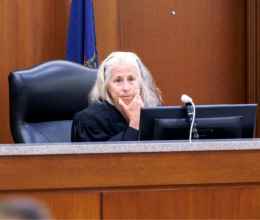For those of us who are lucky enough to get to spend our first year or two after law school working for a judge, the experience invariably shapes our expectations about who a judge is and how she should go about her work. My judge set a high bar (clerks always use the possessive when referring to their bosses). Justice Susan Calkins was both the model of the kind of lawyer that I hoped to be--one who tries to use the law to make people's lives better--and the kind of judge that I hoped would hear my client's cases--careful, thoughtful, and conscious of the real-world impact of legal interpretation. We decided at the ACLU of Maine that we would write blog posts about women that we admire for Women's History Month, and it didn't take me long to decide on a topic (though Ed's choice of Joan Benoit Samuelson is pretty great too).
Susan Calkins began her legal career at Pine Tree Legal Assistance in 1970, as a fellow in the Presque Isle Office. Three years later, she became the director of Pine Tree, which she led until 1976. The 1970s were a time of great expansion and experimentation in legal services. The landmark welfare reform cases like Goldberg v. Kelly gave lawyers for the poor new opportunities to protect their clients. Pine Tree Legal was at the forefront of these developments, and Susan, her husband Hugh and Portland attorney Bob Mittel brought one of the most important civil rights cases of the era, Maine v. Thiboutot, which recognized that the federal civil rights act, 42 U.S.C. 1983, can vindicate statutory as well as constitutional rights.
Susan was appointed to the Maine District Court in 1980, and she was later named the first Chief Judge of that court. She served briefly on the Maine Superior Court, and in 1998 she was appointed by Governor King to the Maine Supreme Judicial Court, where she served until 2007.
I worked for Justice Calkins from 2002 to 2003, and one of the things that really stuck with me was how hard she worked. I don't think I was ever in the office before her, and on days when the Court was not hearing cases, it seemed like she rarely left her office--reading through briefs, drafting notes to herself, her clerks, and her colleagues, drafting opinions. The first case that I was assigned to research as a clerk involved moose hunting. Not having studied moose hunting law in school, I was inclined to think this was perhaps a joke played on the new clerk from out-of-state. But for Justice Calkins, there was really no such thing as a joke case--every case involved real people, and the court's decisions would have a substantial impact on their lives. She was always cognizant of that, and she taught us to be cognizant of it as well.
If you visit the Maine Supreme Judicial Court courtroom in Portland, you can see Justice Calkins's picture over the seating gallery to the right of the bench. John Hart Ely once wrote of his judge, Chief Justice Earl Warren, that you don't need many heroes if you choose carefully. I have always found captures my feelings about my judge as well.
The Judge
Related Issues
Related content

Weekly Highlights: March 31 – April 4
April 4, 2025
Weekly Highlights: March 17 – 21
March 21, 2025
ACT: Ask Lawmakers to Uphold the Right to a Speedy Trial

What a Landmark Ruling Means for Public Defense in Maine
March 7, 2025
Court Orders Maine to Provide Counsel and Create Plan to End...
March 7, 2025
Weekly Highlights: March 3 – 7
March 7, 2025
ACLU Urges Lawmakers to Support Speedy Trial Protections
March 3, 2025
Want to be a Good Samaritan in Maine? Be Careful What Words You Use.
February 28, 2025
